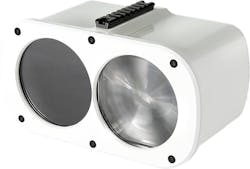Lights for illumination? That’s so 2017. The latest Li-Fi project at Fraunhofer puts them to use for data transmission and nothing else, at distances up to 200 m. Available in Japan.
By now, many people are familiar with what Li-Fi is. It’s an emerging technology that makes double use of illumination by embedding data in LED light waves, thus using luminaires not only as light sources — what a concept — but also as Internet transmitters that tap the light spectrum rather than Wi-Fi’s and cellular’s radio frequencies.
Right? Well, yes.
Interested in articles & announcements on Li-Fi?
But just when we were all getting our heads around that, Germany’s Fraunhofer Heinrich Hertz Institute (HHI) has turned the concept of lighting on its head, developing a Li-Fi transmission box called the LED Backhaul in which the light waves have nothing to do with illumination, but everything to do with data communications.
Fraunhofer HHI was so uninterested in illumination with its new optical transmitter that it decided to use infrared light, which, as part of the non-visible spectrum, is useless for general illumination. But the Berlin-based group deemed the technology as a handy and affordable way for slinging data back and forth between outdoor facilities up to 200 m apart, and is positioning it as a part of future 5G communication schemes. It has teamed with Japanese telecommunications company Sangikyo.
“We are using infrared LEDs because we do not want to combine illumination with data transmission,” Fraunhofer project manager Dominic Schulz told LEDs Magazine. “The technology we developed is not used indoors but outdoors. You can think of it as a smart wireless cable replacement for point-to-point communication. For example, if you want to connect two buildings on a university campus but you do not have the money nor the possibilities to deploy a fiber connection.”
Design elegance need not be a priority when your “light” has nothing to do with general illumination, but everything to do with data communications.
Sangikyo is distributing the LED Backhaul and is currently “planning multiple deployments for several customers,” Schulz told LEDs, adding that “there are several prototype outdoor installations in Germany, Portugal, and Japan where the technology is tested under real-world conditions.”
Li-Fi proponents like to point out that, if nothing else, the technology is a way to add a vast amount of wireless spectrum in a world where bandwidth can be constrained, and where Wi-Fi is rapidly saturating and clashing with other Wi-Fi signals. Enthusiasts typically say that Li-Fi is also more secure than Wi-Fi. They often claim it is faster, although real-world implementations can be nowhere near as fast as blistering speeds in the laboratory.
Fraunhofer HHI repeated many of those claims for the LED Backhaul. “We make use of the beneficial properties of the light, like higher security, high data rates, robustness against electromagnetic interference, etc., while transmitting in the near-infrared band,” Schulz said.
A Fraunhofer spokesperson also pointed out that “apart from backhauling, the newly developed LED Backhaul can be used as a flexible network, as a form of LAN extension if no cable is available,” and said that the technology could serve places like factories or subways “that are not easily reached by radio waves.”
The more commonly known form of Li-Fi for general illumination has been hampered by high costs, among other things. But it continues to make slow advances, such as Philips’ small pilot in the Paris offices of French real estate company Icade.
Fraunhofer itself has also been working on general illumination Li-Fi. For instance, it has installed a prototype at a German high school to transmit lessons to students’ laptops, and has demonstrated a system in which factory floor robots send information via the lights to help make and inspect cars.
Meanwhile, the lighting industry continues to embrace radio technologies as well as optical communications as it attempts to transform itself into more of a data and information technology industry.
For example, just as Fraunhofer has 5G in its sites with the LED Backhaul, so too is Osram eyeing 5G in a new partnership with Nokia to embed 5G radio gear inside luminaires. 5G, generally expected around 2020, marks the next big leap in mobile networking speeds and bandwidth.
MARK HALPER is a contributing editor for LEDs Magazine, and an energy, technology, and business journalist ([email protected]).






